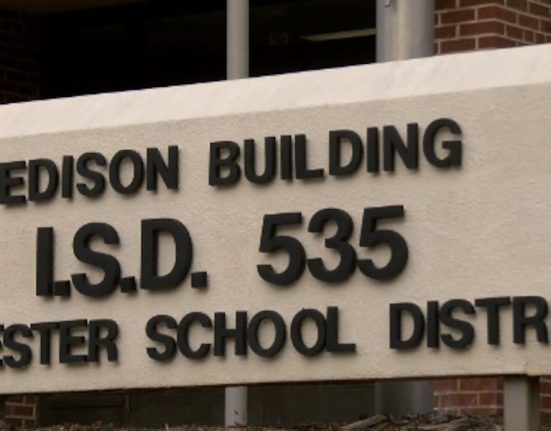This story was originally published by Chalkbeat. Sign up for their newsletters at ckbe.at/newsletters.
By Jason Gonzales, Chalkbeat
In an eagerly awaited email, Colorado Speaker of the House Julie McCluskie told school district leaders Tuesday that proposed legislation she’s crafted would avoid steep funding drops for districts with declining enrollment.
For weeks, McCluskie has negotiated the deal, which would scale back promised financial increases for Colorado schools. The bill represents a compromise between the funding boost that school districts agreed to as part of a funding formula change last year and the savings that Gov. Jared Polis and lawmakers said are necessary due to the state facing a $1.2 billion budget hole next year.
McCluskie said in the email she plans to file the legislation, known as the Public School Finance Act, on the same day. The bill proposes rolling out the state’s new school funding formula over seven years instead of six, which means districts will see their per-pupil dollars increase more slowly.
The proposal would then slowly change the way the state calculates enrollment, moving from a four-year average to a three-year average, which could mean less money for districts with declining enrollment. But the bill would ensure that for the next two years, no school district gets funded at levels lower than this year. It also has triggers that could pause the formula’s implementation in the case of further state budget challenges.
McCluskie’s announcement came a day after the Joint Budget Committee released a $43.9 billion budget proposal that includes a $150 million general fund increase for schools — raising total statewide K-12 spending to about $10 billion.
Lawmakers on the powerful budget committee have needed to make numerous cuts because of a $1.2 billion budget shortfall but were adamant about preserving operational funding increases for schools.
Along with McCluskie, state Rep. Meghan Lukens, a Steamboat Springs Democrat; Senate Minority Leader Paul Lundeen, a Monument Republican; and state Sen. Jeff Bridges, a Greenwood Village Democrat, will sponsor the legislation. The bill will be heard first in House chambers, according to McCluskie.
Last year, lawmakers and districts agreed to update a 30-year-old school finance formula that calls for $500 million more a year for schools, with the funding to be phased in over six years.
The state is also required to finance schools adjusting annually for inflation plus the state’s student population count. The state had been using a five-year enrollment average for that figure for years, but lawmakers bumped it down in the new finance formula to four years.
But in November, in light of the budget shortfall, Gov. Jared Polis’ 2025-26 budget proposed to eliminate student averaging altogether. Polis argued enrollment averaging keeps students no longer attending school on the books and causes the state to send extra money to those schools. His proposal would save money that he said would be reinvested into schools.
District leaders quickly criticized the proposal. They have argued the purpose of averaging helps ensure single-year enrollment declines don’t cause big swings in state funding. They also said Polis’ proposal, as well as less funding than expected due to the budget situation, doesn’t fulfill last year’s school finance formula deal.
Despite the disagreement, Polis said in an interview last month he’s open to phasing out averaging over a number of years. He said his eye has been toward maximizing funding and that his administration is “deeply committed to funding students where they’re at,” instead of funding what are known as “ghost students,” or students who are no longer enrolled in a district. With enrollment averaging, districts could still get funding for students who’ve left.
McCluskie’s bill might bridge the gap between the two sides.
In an email attachment, McCluskie laid out how the bill would impact education in the state.
The bill first extends the implementation of the formula from six years to seven to reduce the strain on the budget and the State Education Fund, a sort of state education savings account. State lawmakers have used the savings account to help fund schools in recent years because of its large balance.
The bill would require next year for the state to spend 15% of the $500 million investment needed to change the state formula, or about $75 million. That’s slightly less than the 18% of the $500 million promised last year.
New funding for the formula would increase to 30% of what’s called for to implement the new formula in 2026-27 and 45% in 2027-28.
“We will only move on to the next tier if the funding is sustainable and we are able to invest more in schools,” she said in the email to districts. “If the state’s budget doesn’t allow for more investment in schools in the future, then we’ll pause further implementation and just meet the inflationary increases, as mandated.”
McCluskie then addressed the enrollment count issue by maintaining a four-year average in next year’s budget. The bill would then move to a three-year count in future years unless the State Education Fund’s balance dips below $200 million.
The proposal would allow lawmakers time to figure out how to address declining student enrollment while also continuing to invest in formula changes, according to the document. It says in future years, lawmakers would only change how it calculates student enrollment if the state is moving toward fully funding the new formula.
The state would also “hold harmless” schools to ensure in 2025-26 and 2026-27 their budgets do not lower below this year’s funding levels. And then the bill instructs the budget committee to continue to annually review the formula and develop a sustainability plan for full funding.
Jason Gonzales is a reporter covering higher education and the Colorado legislature. Chalkbeat Colorado partners with Open Campus on higher education coverage. Contact Jason at [email protected].






